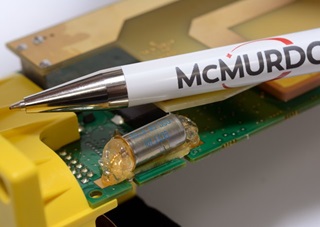Emergency response experience center opens
McMurdo offers insiders a look behind the scenes

McMurdo, a company that specializes in emergency readiness and response—by offering integrated products from aircraft emergency locator transmitters (ELTs) and locator beacons to search-and-rescue coordination hardware and software—has opened the Emergency Readiness and Response Experience Center in Lanham, Maryland, outside of Washington, D.C. The state-of-the-art center showcases the latest technology developments for search and rescue, and has the ability to demonstrate the complete search-and-rescue process—from distress beacon activation to satellite-based location determination to emergency response coordination.
The center, which is not open to the public, educates customers, partners, government representatives, and other invited guests about different search-and-rescue technologies. Visitors also have the opportunity to sit at mission control center and rescue coordination center consoles that are similar to McMurdo products currently used by search-and-rescue authorities around the world.
“The theme here is setting up the ecosystem of the SAR technology,” said Christian Hillier, director of business development. “We’ve got a long history in aviation beacons and other parts of search and rescue.”
McMurdo has acquired Kannad, which makes the Integra line of aviation ELTs, as well as maritime and military beacons; and Techno-Sciences, which provides Cospas-Sarsat infrastructure, as well as mission control and rescue coordination systems. Other units of the company make maritime beacons (EPIRBs) and personal locator beacons (PLBs), and are involved in coastal surveillance and fleet management communications. Parts of the company have been around since 1952, when it developed one of the world’s first military search-and-rescue beacons. All operations will assume the McMurdo brand this year.

The company sits on RTCA, ICAO, and other workgroups, said Christian Belleux, manager of the aviation and military business unit. “We’re really defining the future of technology, and the future capabilities,” he said. Capabilities encompass general and commercial aviation, the military, marine, fishing, and outdoors markets. “The technology spreads across many segments. The quality required by commercial aviation is driving the capability globally. It’s a good mix.”
The commercial version of the Integra ELT receives position information from the aircraft’s flight management system, but it’s also autonomous—with built-in 406 MHz and GPS antennas. “We needed a fail-safe solution on the 406-MHz antenna, and also for the GPS,” Belleux said. A general aviation version is also offered. Battery replacement is required only every six years. “It’s all digital, and it’s new technology in the battery,” he said.
Soon the facility will feature a working medium earth orbit search and rescue (MEOSAR) satellite-based search-and-rescue system console, which represents the next generation of the current Cospas-Sarsat satellite system credited with saving more than 37,000 lives since 1982. Once it’s fully deployed in the next three to five years, MEOSAR will enhance the existing SAR process with global coverage, near-instantaneous distress beacon detection, and a unique return link service that acknowledges receipt of a distress signal. Accurately detecting and locating a distress beacon signal today requires up to 30 minutes.
On Sept. 3, McMurdo announced Prisma MCCNet, new software designed to improve the Cospas-Sarsat satellite-aided search-and-rescue process. The software provides mission control center operators with tools that help them to better identify, locate, and manage distress situations. For example, unified communications and automated reporting help a mission control center to more efficiently coordinate with various rescue coordination centers, streamlining the search-and-rescue process.
Technologies like the new software are likely to make their way to the Experience Center. “Our decades of experience in pioneering the latest SAR advancements, our leadership position as the only company that provides an end-to-end SAR ecosystem, and our ongoing commitment to saving lives put us in the unique position to showcase these emergency readiness and response solutions for our customers, our partners, and the industry,” said Jean-Yves Courtois, McMurdo’s CEO.
Its search-and-rescue systems are used by NOAA and NASA in the United States, as well as by Australia, New Zealand, Cyprus, South Africa, and Argentina, among other countries.



